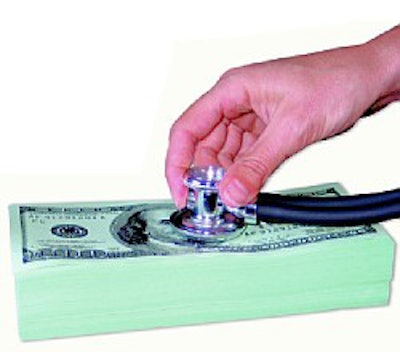

For most employers, the cost of health insurance is a front-burner issue that only seems to get hotter as the flames get higher. Premium increases have registered in the double digits for three years running, according to surveys conducted by the Kaiser Family Foundation in Menlo Park, Calif. And, many businesses with fewer than 50 employees are seeing premium increases from 18 to 35 percent, reports the Midwest Business Group on Health, a Chicagobased consortium of 80 employers.
Such increases are not sustainable. No wonder the National Federation of Independent Businesses cites affordable health insurance as the No. 1 small business concern.
Is the only answer to drop health insurance altogether? Not necessarily. More employers are looking at a new vehicle called the Health Savings Account (HSA), which promises to reduce wasteful medical spending by appealing to employees' selfinterest. Under these plans, the individual who spends less money on medical care ends up with more cash in pocket. And, employee control over medical spending means a lower financial burden for the employer. "There is likely to be an explosion of employer interest in HSAs," says Mark D. Wincek, partner and head of the benefits and compensation practice at the law firm Kilpatrick Stockton in Washington D.C. "These programs allow consumers to actually function like consumers. That reflects a genuine paradigm shift."
Indeed, business owners are lining up for more information. Three out of four employers say they will consider taking on HSAs, according to a new survey from Mercer Human Resource Consulting in New York. Nearly one in five employers are "very likely" to offer an HSA by 2006 and more than half say they're "somewhat likely" to offer the new plans by that time.
HSAs took effect January 1 of this year, and, while many employers are launching the plans now, Wincek expects the ball to roll faster in 2005 and the following year.
The HSA Lowdown
An HSA combines two financial vehicles. The first is a personal, employee-owned savings account dedicated to money earmarked for future medical needs. The second is a high-deductible health insurance plan. This plan kicks in when medical expenses exceed the specified deductible. Trustees for HSA plans may be any of a number of financial institutions such as banks, credit unions and insurance companies.
Both the employer and the employee can make contributions to the savings account. Employer contributions are excluded from employee income for tax purposes; however, employee contributions are deductible from taxes. Annual contributions can be made up to the deductible, which must be at least $1,000 for individual coverage and at least $2,000 for family coverage. Annual out-of-pocket costs (including deductibles and co-pays) do not exceed $5,000 for individuals and $10,000 for families.
Money withdrawn is not taxable if it is used to pay for qualified medical expenses, including specialist visits, drugs and long-term care services, as well as the purchase of continued health care coverage forthe unemployed individual (via COBRA). The interest and investment earnings generated by the account also are not taxable while they remain in the HSA.
Funds withdrawn for non-medical purposes are included in the account holder's gross income, taxed accordingly and subject to a 10 percent penalty.
Come retirement, the money in the savings account can be withdrawn without penalty.
Given the above description, it's apparent how health care expenses are reduced: Employees will spend money only on health care that's really needed. The less the employee spends, the bigger the accumulated nest egg. Smart consumers will ask questions such as these: Is that generic drug as powerful as the expensive name brand? Is the procedure the physician wants to do really necessary? And, for that emergency room visit that seemed so automatic in the past, would a Monday-morning office appointment be more appropriate for the symptom? "As an employee, I know that I will save money if I take a little more active role in my health," says Marcus B. Newman, an employee benefits consultant at GCG Financial, an insurance services firm in Bannockburn, Ill. "It encourages me to be more attentive."
A Winning Situation
So, less money will be spent on health care as employees become careful medical shoppers. But, will prudent spending translate into lower insurance costs for employers? The answer is most often "yes" for smaller organizations facing large premium hikes. Newman gives an example: One of his clients has three employees in a traditional health insurance plan now facing a 39 percent premium hike that will bring monthly outlays to $3,700. By switching to an HSA with a monthly outlay of $3,072, the group will save nearly $8,000 in annual premiums.
An attractive feature is that employers need not put any money into the savings accounts, although they may opt to do so. "Employers can say, 'We will put less money on the table,'" points out Wincek. "Such employers may feel better about switching to HSAs because they have been thinking of getting out of the business of providing health care altogether." Putting the employer in the driver's seat is one of the biggest attractions of HSAs: Business owners can feel more in control of premium levels.
The HSA as a full-replacement product for smaller employers, then, is looking pretty good. Larger businesses, on the other hand, will be loathe to dissolve their current insurance offerings but likely will add HSAs as an additional option. In such cases, employer contributions to the HSA will need to be equivalent to those of other plans.
Whether these larger employers will enjoy savings is still an open question. "To some extent, the larger employers will need to make a leap of faith," Wincek says. "A lot of them are saying, 'I'll give the HSA a shot. I'm not sure it will be better, but I am frustrated with how things have gone under my current set of alternatives, and I am going to try something new.'" As their employees spend less money on health care, these larger employers may find premiums rising more slowly than in the past.
The Catch
Nothing good comes without cost. And while HSAs seem like an imaginative solution to the health insurance puzzle, there is a hidden price: The programs require employees to shoulder more responsibility for their own insurance plans. That means a level of labor, and of attention to detail, to which individuals are unaccustomed. "HSAs have a layer of administration that is not part of a traditional health insurance plan," Newman says. "It requires a personal relationship between the employee and the organization that administers the HSA."
First, the employee must make sure the proper paperwork is filed with the sponsoring organization for each health care expenditure. If correct procedures are not followed, the expense may not be counted toward the annual deductible. Second, the employee must make sure each expenditure is allowed under the terms of the high deductible health insurance policy to avoid the risk of unanticipated additional expense.
Here's an example of how such additional expense can arise. Suppose the employee spends $1,500 on a procedure such as Lasik eye surgery, which is not listed in the insurance company's Explanation of Benefits (EOB). Despite such exclusion, the individual is allowed to pay for the procedure using funds from the health savings account. The problem, though, may arise down the road. Suppose the individual incurs an expensive medical emergency later in the same year. The individual may expect the insurance company to pick up the tab after the $2,000 deductible is reached, and may figure that the $1,500 spent on Lasik surgery counts toward the deductible. But, the insurance company points out that the $1,500 spent was for a procedure not listed in its EOB. Bottom line: The individual will have to spend another $1,500 out-ofpocket before the deductible is reached and the insurance company starts paying.
The burden of responsibility, then, is being shifted from the financial shoulders of the employer to the employee. "HSA funds need to be used wisely, or there won't be enough money left over to pay for necessary medications and procedures," Wincek says.
The moral is clear: Employees will need to sit down and read the lengthy, fine print of the EOB to figure out what procedures are reimbursable. "In the past, people have tossed their EOBs into the garbage," Newman says. "With an HSA plan, you absolutely have to read them."
Of course, reading the fine print of insurance policies and managing financial paperwork are not the most popular activities for most of us. The problem is even worse for individuals without a firm command of the English language. "These plans will be problematic for organizations with nonEnglish speaking work forces," Newman warns. "Most of the instructional material is in English."
Lowering the Heat
Are HSAs right for your company? They come with significant advantages, especially for smaller employers looking at unsustainable premium hikes. In such cases, HSAs are circuit breakers for health insurance programs that have grown too hot to handle.
Succeeding with an HSA, though, takes communication. Employers must make their employees aware of the program's financial rewards and convince them to take a closer interest in managing their own health care. Finesse the educational demands, and you may find an HSA a great way to lower the flames under the health insurance pressure cooker.
The Lowdown on Healthy Spending
• For the most comprehensive information about Health Savings Accounts (HSAs), visit the U.S. Department of the Treasury Web site at www.treas.gov/offices/public-affairs/hsa/.
• The law firm of Kilpatrick Stockton has a continuing round of reports on HSAs. To view them, go to www.kilpatrickstockton.com, click on "Publications" and then on "Legal Alerts." Then, scroll down to the "Employee Benefits" section.
• Search for an insurance company and a trustee at The HSA Insider Web site, at www.hsainsider.com. This site also has links to the latest news stories about HSAs and FAQs.
• For basic information about HSAs, see "A Consumer Guide to Health Savings Accounts." (Despite its name, this presentation also is useful for employers.) Go to the Web site for the National Association of Health Underwriters at www.nahu.org/consumer/HSAGuide.htm.































